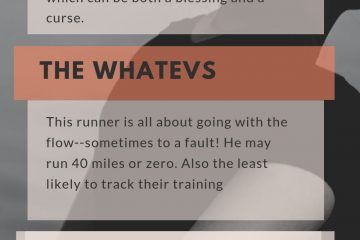7 sneaky ways to run faster in 2019

If you’ve been running regularly for six months or more and your progress has plateaud, it’s time to take things up a notch! Read below for tips on how to improve your running.
When I first started running as a teenager, I had no clue what I was doing. I mean, I did everything wrong!
- I’d sign up for races and ramp up training a few weeks before the event.
- I’d add in (last minute) weight training in an attempt to strengthen my legs.
- I’d totally change my diet (the week of the race) based on what the latest fitness magazine said.
Why didn’t I just run more?
The problem was chasing quick results instead of slow and steady improvement. The truth was, what I needed to do was well…boring.
How to really improve your run
Of the training tenets you can manipulate—volume, intensity, duration, and frequency—one of the most underrated and underutilized variables is frequency. Many athletes fall into the trap of infrequent runs that are then too intense or long for their training to support.
A common example is the athlete who will do a very long run on the weekend and perhaps one other tempo to all-out run during the week and call it good. This stunts progress and often leads to injury. Don’t let this happen to you. Increase your run durability by practicing proper frequency.

Here are some tips for improving your run:
Increase frequency—
If you’re currently a student of the run twice a week group, then build up your frequency slowly.
Why:
High frequency leads to increased durability, which makes you more resistant to injury, and better able to hold pace and form at the end of the race. An athlete only running twice per week can reap benefits by gradually increasing to 5-6 weekly runs.
A pro of upping the frequency of your runs is that it helps the athlete build muscular endurance while allowing you to take some of the emphasis off of very long runs (such as getting in a certain number of 20 miles runs for a marathon or IRONMAN). Avoiding the steep recovery cost of lots of super long weekend runs can in turn allow you to focus on adding in more quality down the road while avoiding injuries.
One potential downside to frequency is the transition time (driving, showering) required by adding these additional workouts. This can be alleviated by making many of your workouts bricks. Also, you still need to find the balance between quality and quantity. If you’ve been falling into the trap of running all your workouts hard, then running daily will force you to nix the habit.
How:
Anyone can benefit from more frequent running. Start by dividing your current volume into more runs before adding in additional time. For triathletes running 20 plus miles per week already, increasing frequency can simply mean dividing your current weekly mileage into 5 or 6 runs instead of 2-3 runs.
Add Intensity—
After you’ve built up frequency, then add in some intensity. An easy way to add in intensity is to run once a week with others who are slightly faster. Less is more here. You’re likely also getting intensity from swim and bike workouts, so you need less quality (speedwork or hills) than you would as an open runner.
Why:
Finding the right balance between quality and quantity can be tough even for experienced athletes. To complicate matters, triathletes have to balance quality and quantity in three separate sports.
Some form of quality running is an important part of a well rounded training plan. Yet seasoned runners also understand that running every run all out is a quick way to top out and get injured.
How:
If you’re new to speedwork we propose keeping it simple to start.Before you begin, first build to a sustainable and appropriate level of frequency and volume comprised of easy to moderate runs. Then, assuming you’ve been running regularly for 6 months it’s appropriate to then add in a regular tempo run.
We’ll define tempo as the pace you can hold for about an hour, or for most runners, between 10k and half marathon pace. Start with continuous tempo runs of about 20 minutes and gradually increase to about 45 minutes.
Add Volume–
No magic here. If you can increase your workload over time and absorb that load, you will improve. For many triathletes barely touching the double digits, higher volume can mean increasing from miles in the 10-20 per week range to the 30-40 a week range.
Why:
The benefit of focusing on volume is that it’s easy to track and proven to work. Just pick a simple metric to track- time or miles, and focus on increasing weekly time at a rate no greater than around 10% a week
How:
Avoid the pitfall of increasing miles too quickly, and be sure to keep a balance of training between sports. Many triathletes eventually find a point of diminishing returns with run mileage, where it makes more sense to rest with additional time or where the recovery required from additional runs cuts too much into the energy required for quality cycling
If you plan to increase volume substantially, consider devoting a chunk of time solely to running (such as winter) where you’re willing and able to scale back on other sports. Keep a small amount of cycling and swimming in the plan, while keeping the recovery cost from those sports low.

Other Ideas–
Set midterm goals—Stay motivated and track your progress with periodic winter races.Targeting an off-season PB in 5K, 10K, or even half marathon will set you up to start the season off strong.
Consider joining a group—Solo, near daily runs can get boring. Our athletes at Atlanta Tri Club are all ages and ability levels.
Consider hiring a coach—A good coach can evaluate your strengths and weaknesses and recommend a personalized approach to attack your run. Our coaches at Energy Lab work with all levels.
Sign up for an event- Having a running event on the schedule is the perfect way to add some stakes to your run game? Sound intimidating? You got this. Here’s a free guide to picking your very first finish line. Just let me know where to send it.
Want help taking your run to the next level this year? Start by filling out our one on one coaching application or check out our schedule for group training!
Looking for courage to try something new? I’m here for that. Join 1470 others for a mostly-weekly dose of mojo.
Here are some other ideas for your fitness journey:
- Ultimate Guide: How to start cycling
- Find your runner personality [ to go faster]
- Top 4 worst new runner mistakes
- How does Garmin race predictor work?
- The real deal on getting back in shape after baby

Hi, I’m Bethany–coach, author of Courage to Tri, 2x Kona qualifier, and twin mom. I believe if you have a body you’re an athlete. Grab my free 5k plan to start your own athletic journey.
like this idea? pin it!


Add these exercises to bullet proof your body:
Next up: Should I run by pace or heart rate?



12 Comments
Brittany · February 22, 2019 at 12:30 am
I appreciate this article. I am currently pregnant, due in 10 weeks. I really want to get back into shape post postpartum and I think these tips will help me gradually increase running after being out of the game for a while.
Bethany · February 22, 2019 at 3:12 pm
Congrats on your pregnancy! Yes…as someone who is coming back to it now, I’m having to keep slow and steady more in mind than ever.
Jacalyn · February 23, 2019 at 2:06 am
Such good advice! I stopped being able to run comfortable when I was 12 weeks pregnant thanks to pubis dysfunction, and it took months and months after baby to be able to run without pain. Now I’m trying to hit the road and gym again, and this is just the push I need to help with my splits. Thanks!
Megan · February 27, 2019 at 4:11 pm
This is great advice for running! I am not a runner, but I feel like this tips can be used for all types of exercise. Being consistent is key for me!
Maia · February 27, 2019 at 5:18 pm
I’m a reluctant runner (it really isn’t my thing but find me a more affordable way to get in your cardio!), and I feel like this is such good advice. Frequency is so important for habit-building.
Bethany · February 28, 2019 at 6:18 pm
Yes, I agree. Good point that the frequency has much broader application.
Sarah @ Sweet Miles · February 27, 2019 at 9:07 pm
Love this! I’m getting back into shape and working towards running long distances again, but man, running after two babies is no joke!
Bethany · February 28, 2019 at 6:17 pm
Keep at it! I totally resemble that remark… but it will get easier for us.
Anh · February 28, 2019 at 2:08 am
Thank you for these tips! I was a runner before having my son, but I think I’m going to start running again in the spring and will use these tips!
Kim · February 28, 2019 at 10:08 pm
These are all great tips for runners! I’ll have to share this with a friend of mine. Thanks for sharing.
Holly Martin · March 27, 2019 at 9:36 am
Great post-Bethany! Beginners and experts alike will at some point experience a stage of a plateau. But this can be overcome by taking things day-by-day, going the extra mile (literally!) and sometimes doing a little more than what your usual training requires. A good running coach & a proper training plan can definitely help this process.
Bethany · March 27, 2019 at 2:35 pm
Thanks for commenting. Plateaus are just part of life! And it’s always nice to have an objective outlook from a coach.
Comments are closed.